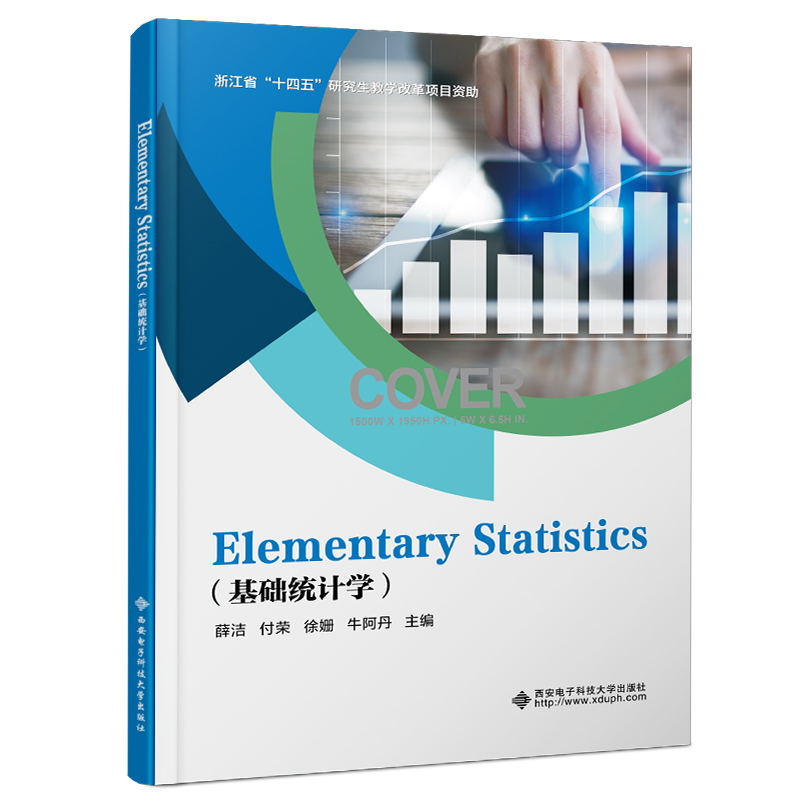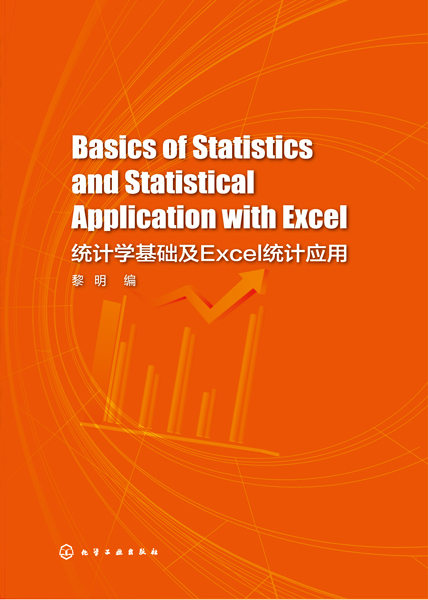基础统计学(英文) / 浙江省“十四五”研究生教学改革项目资助教材,杭州电子科技大学立项资助出版教材
定价:¥34.00
作者: 薛洁
出版时间:2024-08
最新印次日期:2024-9
出版社:西安电子科技大学出版社
- 西安电子科技大学出版社
- 9787560673219
- 1-1
- 531080
- 61251504-9
- 16开
- 2024-08
- 管理学
- 工商管理类
- 管理学
- 本科
目录
Chapter 1 Introduction to Statistics 1
1.1 An Overview of Statistics 1
1.1.1 A Definition of Statistics 1
1.1.2 Research Objects and Properties of Statistics 3
1.1.3 The Basic Process of Statistical Study 4
1.2 Statistical Origin and Development 7
1.2.1 Development History of Statistics 7
1.2.2 Development Direction and Trend of Statistics 9
1.2.3 Applications of Statistics in Various Fields 12
1.3 Data Classification 15
1.3.1 Types of Data 15
1.3.2 Levels of Measurement 16
1.3.3 Other Data Types 19
1.4 Basic Concepts of Statistics 19
1.4.1 Population and Sample 19
1.4.2 Population Parameters and Sample Statistic 21
Chapter Review 22
Exercise 22
Chapter 2 Data Collection 24
2.1 Methods of Data Collection 24
2.1.1 Surveys 24
2.1.2 Observation and Experiment 27
2.2 Statistical Survey and Design 28
2.2.1 Statistical Survey Plan Design 28
2.2.2 Questionnaire Design 30
2.3 Sampling Techniques 32
2.3.1 Simple Random Sampling 32
2.3.2 Stratified Sampling 33
2.3.3 Cluster Sampling 34
2.3.4 Systematic Sampling 35
2.3.5 Non-probability Sampling 35
2.4 Sampling Error and Non-Sampling Error 37
2.4.1 Sampling Error 37
2.4.2 Non-sampling Error 37
Chapter Review 39
Exercise 40
Chapter 3 Data Grouping and Data Graphing 41
3.1 Frequency Distribution 41
3.1.1 Definition of Frequency Distribution 41
3.1.2 Construction of Frequency Distribution 41
3.1.3 Cumulative Frequency and Cumulative Relative Frequency 47
3.2 Graphs of Frequency Distributions 48
3.2.1 Qualitative Data Visualization 48
3.2.2 Quantitative Data Visualization 50
3.3 More Graphs and Displays 53
3.3.1 Stem-and-leaf Plot 53
3.3.2 Dot Plot 54
3.3.3 Box Plot 54
3.3.4 Scatter Plot 55
Chapter Review 56
Exercise 56
Chapter 4 Characteristics of Data Distribution 59
4.1 Measures of Center 59
4.1.1 Meaning of Measures of Center 59
4.1.2 Mean, Median and Mode 60
4.2 Measures of Variability 69
4.2.1 Significance of Measures of Variability 69
4.2.2 Range,Interquartile Range and Mean Absolute Deviation 70
4.2.3 Variance and Standard Deviation 73
4.2.4 Coefficient of Variation 78
4.3 Skewness and Kurtosis 79
4.3.1 Moment 79
4.3.2 Skewness Coefficient 81
4.3.3 Kurtosis Coefficient 82
Chapter Review 83
Exercise 83
Chapter 5 Probability Basis 86
5.1 Basic Concepts of Probability 86
5.1.1 Random Experiments and Events 86
5.1.2 Set Theory 87
5.1.3 Types of Probability 87
5.2 Addition Rule and Multiplication Rule 88
5.2.1 Addition Rule 88
5.2.2 Conditional Probability 89
5.2.3 Multiplication Rule 90
5.2.4 Independent Events 90
5.3 Discrete Probability Distributions 91
5.3.1 Probability Distribution 91
5.3.2 Binomial Distribution 93
5.3.3 Geometric Distribution 95
5.3.4 Poisson Distribution 96
5.4 Common Probability Distributions 97
5.4.1 Normal Distribution 97
5.4.2 Standard Normal Distribution 98
5.4.3 Characteristics of Normal Distribution and Its Applications 101
5.5 Other Sampling Distributions and Central Limit Theorem 102
5.5.1 Other Sampling Distributions 102
5.5.2 Central Limit Theorem 106
Chapter Review 107
Exercise 107
Chapter 6 Parameter Estimation 110
6.1 Sampling Distribution 110
6.1.1 Basic Concepts of Sampling 111
6.1.2 Sampling Distribution 113
6.2 Point Estimation and Evaluation Criteria 115
6.2.1 Point Estimation 116
6.2.2 Evaluation Criteria for Estimates 116
6.3 Interval Estimation 117
6.3.1 Relations of Interval Estimation to Population Mean 118
6.3.2 Relations of Interval Estimation to Population Proportion 120
6.4 Determination of Sample Size 121
6.4.1 Determination of Sample Size When Estimating Population Mean 122
6.4.2 Determination of Sample Size When Estimating Population Proportion 123
Chapter Review 124
Exercise 125
Chapter 7 Hypothesis Testing 127
7.1 Basic Questions about Hypothesis Testing 127
7.1.1 The Concept of Hypothesis Testing 127
7.1.2 Steps of Hypothesis Testing 129
7.1.3 p-value 131
7.1.4 Comparison of Two-tailed Test to One-tailed Test 131
7.1.5 Two Types of Errors 132
7.1.6 The Power of the Statistical Test 134
7.2 Tests for the Population Mean 135
7.2.1 When the Variance is Known 135
7.2.2 When the Variance is Unknown 136
7.3 Hypothesis Testing of Population Proportion 138
7.4 Hypothesis Testing of Two Population Parameters 139
7.4.1 Test for Difference Between Two Population Means 139
7.4.2 Hypothesis Testing for the Difference Between Two Population Proportions 141
7.4.3 Tests for the Ratio of Two Population Variances 142
Chapter Review 144
Exercise 144
Chapter 8 Correlation Analysis and Regression Analysis 146
8.1 Correlation Analysis 146
8.1.1 Relationship Between Variables 146
8.1.2 Description and Measurement of Correlation 147
8.1.3 Significant Test of Correlation Coefficient 149
8.2 Simple Linear Regression Analysis 151
8.2.1 Definition of Regression 151
8.2.2 Simple Linear Regression Model 152
8.2.3 Estimates of Simple Regression Function 153
8.2.4 Significance Test for a Single Population Parameter 158
8.2.5 Prediction 163
8.3 Multiple Regression Analysis 164
8.3.1 Multiple Regression Model 164
8.3.2 Find A Multiple Regression Equation 165
8.3.3 Predict the Dependent Variable y 167
8.3.4 Coefficient of Multiple Determination 167
8.3.5 Significance Test 168
Chapter Review 171
Exercise 171
Appendix 176
Appendix A Standard Normal Distribution 176
Appendix B Student-t Distribution 177
Appendix C F Distribution 178
References 184
1.1 An Overview of Statistics 1
1.1.1 A Definition of Statistics 1
1.1.2 Research Objects and Properties of Statistics 3
1.1.3 The Basic Process of Statistical Study 4
1.2 Statistical Origin and Development 7
1.2.1 Development History of Statistics 7
1.2.2 Development Direction and Trend of Statistics 9
1.2.3 Applications of Statistics in Various Fields 12
1.3 Data Classification 15
1.3.1 Types of Data 15
1.3.2 Levels of Measurement 16
1.3.3 Other Data Types 19
1.4 Basic Concepts of Statistics 19
1.4.1 Population and Sample 19
1.4.2 Population Parameters and Sample Statistic 21
Chapter Review 22
Exercise 22
Chapter 2 Data Collection 24
2.1 Methods of Data Collection 24
2.1.1 Surveys 24
2.1.2 Observation and Experiment 27
2.2 Statistical Survey and Design 28
2.2.1 Statistical Survey Plan Design 28
2.2.2 Questionnaire Design 30
2.3 Sampling Techniques 32
2.3.1 Simple Random Sampling 32
2.3.2 Stratified Sampling 33
2.3.3 Cluster Sampling 34
2.3.4 Systematic Sampling 35
2.3.5 Non-probability Sampling 35
2.4 Sampling Error and Non-Sampling Error 37
2.4.1 Sampling Error 37
2.4.2 Non-sampling Error 37
Chapter Review 39
Exercise 40
Chapter 3 Data Grouping and Data Graphing 41
3.1 Frequency Distribution 41
3.1.1 Definition of Frequency Distribution 41
3.1.2 Construction of Frequency Distribution 41
3.1.3 Cumulative Frequency and Cumulative Relative Frequency 47
3.2 Graphs of Frequency Distributions 48
3.2.1 Qualitative Data Visualization 48
3.2.2 Quantitative Data Visualization 50
3.3 More Graphs and Displays 53
3.3.1 Stem-and-leaf Plot 53
3.3.2 Dot Plot 54
3.3.3 Box Plot 54
3.3.4 Scatter Plot 55
Chapter Review 56
Exercise 56
Chapter 4 Characteristics of Data Distribution 59
4.1 Measures of Center 59
4.1.1 Meaning of Measures of Center 59
4.1.2 Mean, Median and Mode 60
4.2 Measures of Variability 69
4.2.1 Significance of Measures of Variability 69
4.2.2 Range,Interquartile Range and Mean Absolute Deviation 70
4.2.3 Variance and Standard Deviation 73
4.2.4 Coefficient of Variation 78
4.3 Skewness and Kurtosis 79
4.3.1 Moment 79
4.3.2 Skewness Coefficient 81
4.3.3 Kurtosis Coefficient 82
Chapter Review 83
Exercise 83
Chapter 5 Probability Basis 86
5.1 Basic Concepts of Probability 86
5.1.1 Random Experiments and Events 86
5.1.2 Set Theory 87
5.1.3 Types of Probability 87
5.2 Addition Rule and Multiplication Rule 88
5.2.1 Addition Rule 88
5.2.2 Conditional Probability 89
5.2.3 Multiplication Rule 90
5.2.4 Independent Events 90
5.3 Discrete Probability Distributions 91
5.3.1 Probability Distribution 91
5.3.2 Binomial Distribution 93
5.3.3 Geometric Distribution 95
5.3.4 Poisson Distribution 96
5.4 Common Probability Distributions 97
5.4.1 Normal Distribution 97
5.4.2 Standard Normal Distribution 98
5.4.3 Characteristics of Normal Distribution and Its Applications 101
5.5 Other Sampling Distributions and Central Limit Theorem 102
5.5.1 Other Sampling Distributions 102
5.5.2 Central Limit Theorem 106
Chapter Review 107
Exercise 107
Chapter 6 Parameter Estimation 110
6.1 Sampling Distribution 110
6.1.1 Basic Concepts of Sampling 111
6.1.2 Sampling Distribution 113
6.2 Point Estimation and Evaluation Criteria 115
6.2.1 Point Estimation 116
6.2.2 Evaluation Criteria for Estimates 116
6.3 Interval Estimation 117
6.3.1 Relations of Interval Estimation to Population Mean 118
6.3.2 Relations of Interval Estimation to Population Proportion 120
6.4 Determination of Sample Size 121
6.4.1 Determination of Sample Size When Estimating Population Mean 122
6.4.2 Determination of Sample Size When Estimating Population Proportion 123
Chapter Review 124
Exercise 125
Chapter 7 Hypothesis Testing 127
7.1 Basic Questions about Hypothesis Testing 127
7.1.1 The Concept of Hypothesis Testing 127
7.1.2 Steps of Hypothesis Testing 129
7.1.3 p-value 131
7.1.4 Comparison of Two-tailed Test to One-tailed Test 131
7.1.5 Two Types of Errors 132
7.1.6 The Power of the Statistical Test 134
7.2 Tests for the Population Mean 135
7.2.1 When the Variance is Known 135
7.2.2 When the Variance is Unknown 136
7.3 Hypothesis Testing of Population Proportion 138
7.4 Hypothesis Testing of Two Population Parameters 139
7.4.1 Test for Difference Between Two Population Means 139
7.4.2 Hypothesis Testing for the Difference Between Two Population Proportions 141
7.4.3 Tests for the Ratio of Two Population Variances 142
Chapter Review 144
Exercise 144
Chapter 8 Correlation Analysis and Regression Analysis 146
8.1 Correlation Analysis 146
8.1.1 Relationship Between Variables 146
8.1.2 Description and Measurement of Correlation 147
8.1.3 Significant Test of Correlation Coefficient 149
8.2 Simple Linear Regression Analysis 151
8.2.1 Definition of Regression 151
8.2.2 Simple Linear Regression Model 152
8.2.3 Estimates of Simple Regression Function 153
8.2.4 Significance Test for a Single Population Parameter 158
8.2.5 Prediction 163
8.3 Multiple Regression Analysis 164
8.3.1 Multiple Regression Model 164
8.3.2 Find A Multiple Regression Equation 165
8.3.3 Predict the Dependent Variable y 167
8.3.4 Coefficient of Multiple Determination 167
8.3.5 Significance Test 168
Chapter Review 171
Exercise 171
Appendix 176
Appendix A Standard Normal Distribution 176
Appendix B Student-t Distribution 177
Appendix C F Distribution 178
References 184










